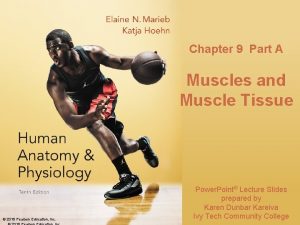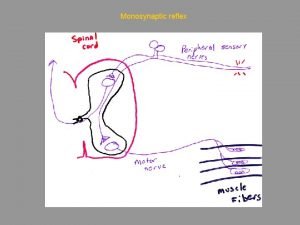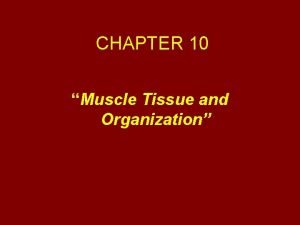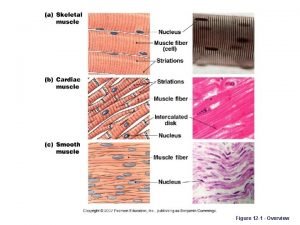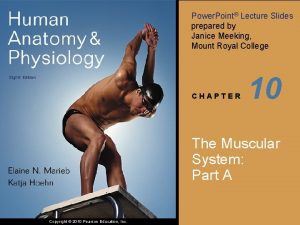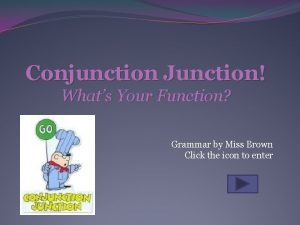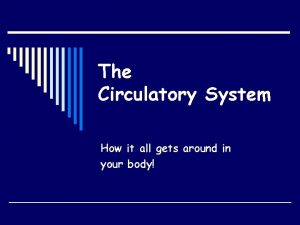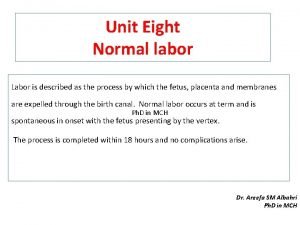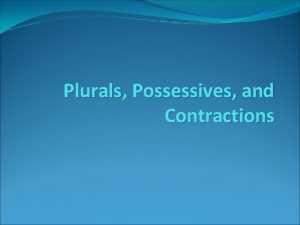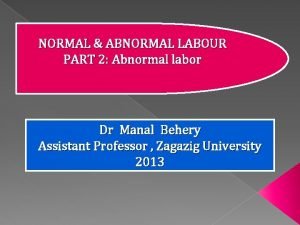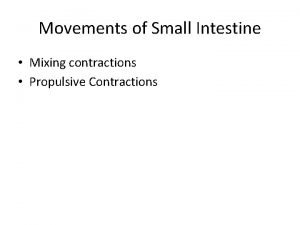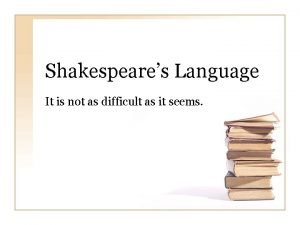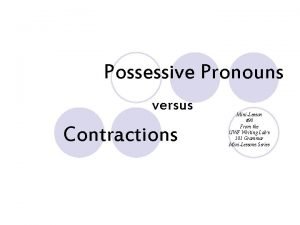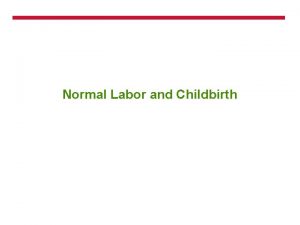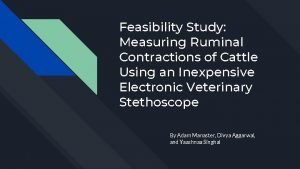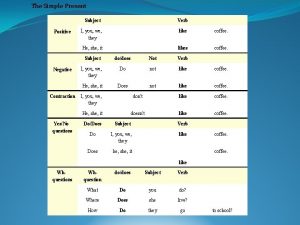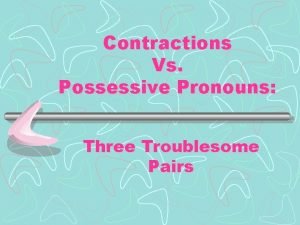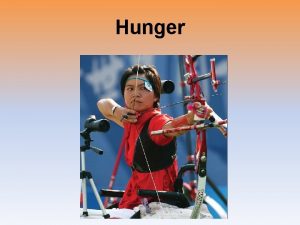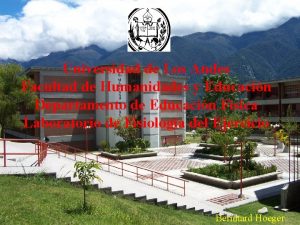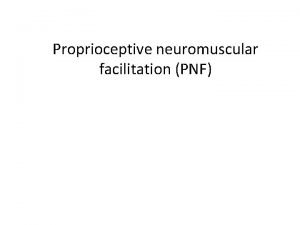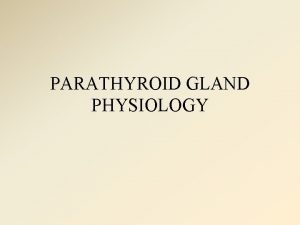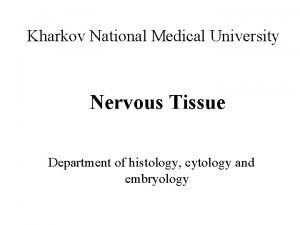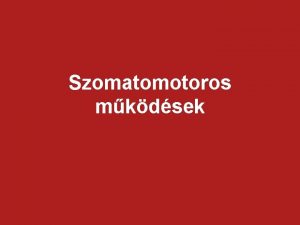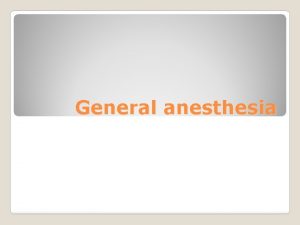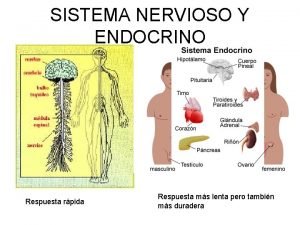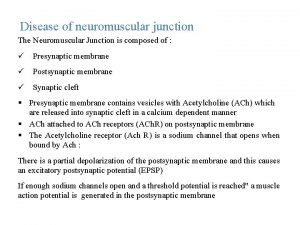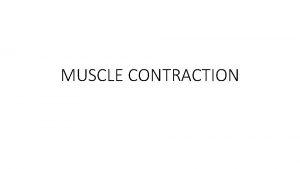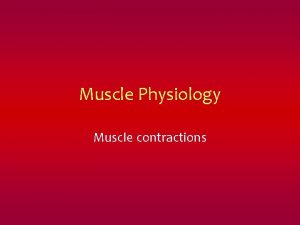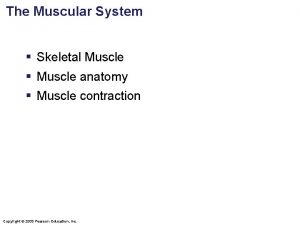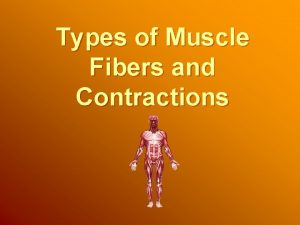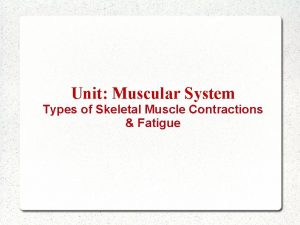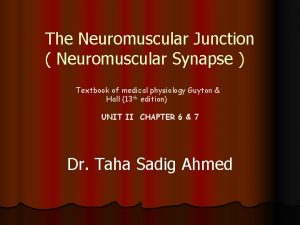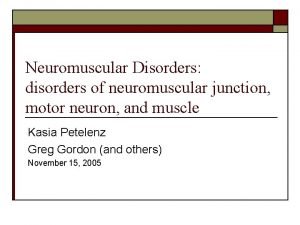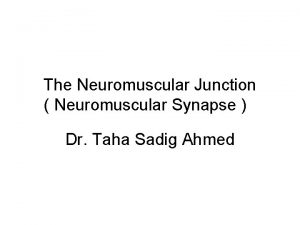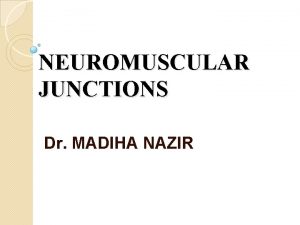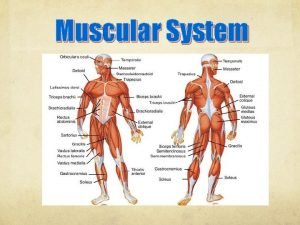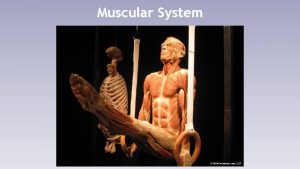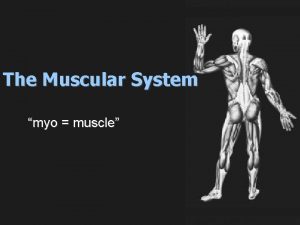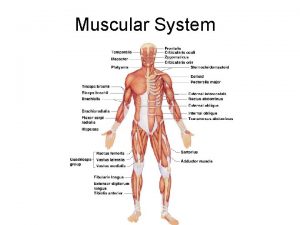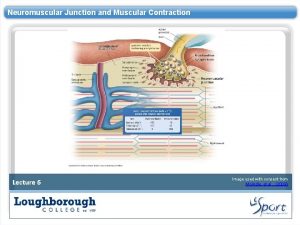Muscular System Muscle Contractions Neuromuscular Interactions Neuromuscular Junction






































- Slides: 38

Muscular System Muscle Contractions

• Neuromuscular Interactions: Neuromuscular Junction: The site where the motor neuron and muscle fiber meet is the neuromuscular junction The muscle fiber membrane (sarcolemma) forms a _______ Motor ____ End _______ Plate in which the sarcolemma is tightly folded and where nuclei and mitochondria are abundant.



Acetylcholine – neurotransmitter released Axon of the neuron. from the _____ Acetylcholinesterase – What is it’s function? Breaks down acetylcholine; stops muscle contraction Where is it found? Motor End Plate Motor neuron and the muscle Motor Unit: A _______ Fiber it controls make up a motor unit; when _____ stimulated to do so, the muscle fibers of the motor unit contract all at once.


• Skeletal Muscle Contraction: Muscle Contraction involves several components that result in the shortening of sarcomeres, and the pulling of the muscle against it’s attachment.

• http: //www. sumanasinc. com/webcontent/animati ons/content/muscle. html • http: //highered. mheducation. com/sites/00724958 55/student_view 0/chapter 10/animation__sarcome re_contraction. html • http: //wps. prenhall. com/wps/media/objects/2688 /2752944/Web_Tutorials/25_A 01. swf

Myosin consists of two twisted strands with • The protein _______ globular cross- bridges projected outward along the strands. Cross Bridge Actin is a globular protein with myosin binding sites. • _______ What two proteins are associated with it? Tropomyosin Troponin


4 1 2 7 6 3 5

• According to the sliding filament theory of muscle contraction, if allowed to, myosin cross bridge attaches to the binding site on the actin filament and bends, pulling on the actin filament; it then releases and attaches to the next binding site on the actin, pulling again. • What prevents this from happening continuously? Aceytlycholinesterase • Energy from the conversion of ATP to ADP is provided to the cross-bridges from the enzyme ATPase, causing them to be in a cocked position.

• Stimulus for Contraction The motor neuron must release the neurotransmitter Aceytlycholine __________ from its synaptic Vesicles Synaptic _________ into the _______ cleft in order to initiate a muscle contraction.

Daily Warm Up 1. 2. C Sarcoplasmic Reticulum ___ G Sarcolemma ___ 3. F T Tubule ___ 4. H ___Troponin 1. I ___Tropomyosin 2. B Cross Bridge ___ 3. J Calcium Ion ___ 4. E ___Sarcoplasm 5. D ___Acetylcholine 6. A ___Acetylcholinesterase a. Enzyme that breaks down acetylcholine b. Part of the myosin filament that attaches to actin c. Net like structure that surrounds each myofibril and stores Calcium ions (Ca 2+) d. Neurotransmitter that triggers a muscle contraction e. Cytoplasm of a muscle fiber f. Tubes are found around the myofibril and signal the sarcoplasmic reticulum to release calcium g. Cell membrane of a muscle fiber h. Protein found on actin that interacts with calcium ions i. Ribbon like protein on Actin that covers up binding sites j. Ion that causes troponin and tropomyosin to shift and expose the myosin binding sites

• Stimulus for Contraction Protein receptors in the motor end plate detect the neurotransmitters, and a muscle impulse spreads over Transvers the surface of the sarcolemma and into the _____ e tubules, where it reaches the Sarcoplasmic ______ reticulum

• Stimulus for Contraction Upon receipt of the muscle impulse, the sarcoplasmic Calcium (Ca 2+to ) the reticulum releases its stored ______ sarcoplasm of the muscle fiber. The high concentration of calcium in the sarcoplasm Tropomyosin molecules, interacts with the Troponin ____ and ______ which move aside, exposing the myosin binding sites on the actin filaments. https: //www. youtube. com/watch? v=g. J 309 Lf. HQ 3 M

• Stimulus for Contraction Cross bridges now bind and pull on the Actin Myosin _______ filaments, causing the sarcomere to shorten. After the nervous impulse has been received, the enzyme Acetylcholinesterase _________ rapidly decomposes the acetylecholine. Then, calcium is returned to the sarcoplasmic reticulum, and the linkages between myosin and actin are broken.


Contraction cycle 1. Start with a cocked myosin head 1. (ADP and P are attached) 2. Myosin head binds to the actin when troponin and tropomyosin move to expose the binding sites 1. (ADP and P are attached) 3. Myosin head goes through the powerstroke and moves the actin filament 1. (ADP and P detach) 4. Myosin head is stuck until ATP releases it from the actin filament 1. (ATP attaches; Myosin head releases) 5. Myosin head goes back into cocked position) 1. (ATP breaks down into ADP and P is still attached to the myosin head)

1. Muscle contractions begin at the neuromuscular junction. 2. The axon of a motor neuron is attached to the motor end plate of a muscle fiber’s sarcolemma. 3. To create a muscle contraction, acetylcholine is released from the motor neuron axon. Acetylcholine will trigger a muscle impulse. 4. The muscle impulse will travel across the sarcolemma and through the muscle fiber via the T tubules. 5. The muscle impulse travelling through the T tubules will cause the sarcoplasmic reticulum to release Calcium Ions into the sarcoplasm. 6. The calcium ions released will attach to troponin and cause the ribbon like tropomyosin to shift. This exposes the myosin binding sites necessary for muscle contraction.

7. Once the myosin binding sites are exposed, myosin cross bridges will attach to the actin and perform a power stroke which will move the actin filaments closer together. 8. The myosin cross bridge is stuck to the actin filament until an ATP molecule attaches. 9. Breaking ATP into ADP and P will cock the myosin head. Preparing it for another Power Stroke 10. In order to stop a muscle contraction, acetylcholinesterase will break down the acetylcholine.

Reading Review • Read from your textbook pages 172 – 178. • On a separate piece of paper, answer the check your recall questions in complete sentences. • 175 (1 -4) • 178 (1 -4)

Muscle Contraction Paragraph • Using the following vocabulary words, write a paragraph explaining how muscles contract. • Neuromuscular Junction, Motor End Plate, Synaptic bulb, synaptic cleft, synaptic vesicles, Acetylcholine, Sarcolemma, Sarcoplasm, Myofibril, T Tubule, Sarcoplasmic Reticulum, Calcium Ions, Actin Filaments, Myosin Filaments, Cross Bridges, Troponin, Tropomyosin, Power stroke, ATP, ADP/P, Acetylcholinesterase.

Review Video • https: //www. youtube. com/watch? v=4201 Sr. N 0 Wl. Y

Daily Warm Up • List the steps of muscle contraction from 1 to 6. 1 being first and 6 being last. 4 1. ___ Myosin cross bridges attach to the binding sites, go through a power stroke and move the actin filaments closer together. 3 3. ___ Acetylcholine is released from the axon of the motor neuron into the synaptic 1 cleft of the sarcolemma triggering a muscle impulse. 6 When the muscle contraction is over, Acetylcholinesterase breaks down 4. ___ acetylcholine. 5. ___ The muscle impulse travels across the sarcolemma and down through the T 2 tubules stimulating the sarcoplasmic reticulum to release Calcium Ions (Ca 2+) into the 2. ___ Calcium ions attach to the troponin causing the tropomyosin to move and expose the myosin cross bridge binding sites sarcoplasm. 5 6. ___ Attachment of ATP to the myosin cross bridge releases them from the binding sites. The breakage of the ATP cocks the myosin cross bridge preparing it for its next powerstroke.

Energy Sources for Contraction ATP: Energy for contraction comes from molecules of ATP. This chemical is in limited supply and so must often be regenerated. Creatine Phosphate: As ATP decomposes, the energy from creatine phosphate can be transferred to ADP molecules, converting them back to ATP. Cellular Respiration: The early phase of cellular respiration yields few molecules of ATP, so muscle has a high requirement for oxygen, which enables the complete breakdown of glucose in the mitochondria. Cross bridges stores oxygen in muscle tissue. The pigment _______ What happens to respiration during exercise? Respiration increases

https: //www. youtube. com/watch? v=BR 3 d. DO 1 Sz 0 E


Oxygen Debt: Oxygen deficiency may develop during strenuous exercise, and Lactic acid accumulates as an ened product of anaerobic ______ respiration. This acid diffuses out of muscle cells and is carried in the bloodstream to the liver. Oxygen debt refers to the amount of oxygen that liver cells require to convert the accumulated lactic acid into glucose, plus the amount that muscle cells need to resynthesize ATP and creatine phosphate to their original concentrations. Repaying oxygen debt may take several hours.

When a muscle loses its ability to contract during Muscle strenuous exercise, it is referred to as ____ fatigue _____. This usually arises from the accumulation of p. H lactic acid in the muscle causing a lowered ____ cramp occurs due to a lack of ATP required to A muscle ____ return calcium ions back to the sarcoplasmic reticulum so muscle fibers can relax.

• HEAT: Why does muscle contraction cause so much heat? Muscles make up a large proportion of the body and therefore give off a lot of heat

Muscle Responses: A muscle fiber remains unresponsive to stimulation unless the stimulus is of a certain strength, Threshold Stimulus called the _________. When a muscle fiber contracts, it contracts to its full extent, it cannot contract partially. This is called the All or ______ none response. ___ __ Muscle Twitch: A single short contraction involving only a few motor units is referred to as a twitch. Is this considered a very useful contraction? No


A muscle fiber receiving a series of stimuli of increasing frequency reaches a point when it is unable to relax completely and the force of individual twitches summation combine by the process of ______. If the sustained contraction lacks any relaxation, it is tetanus called a ________ contraction. An increase in the number of activated motor units within a muscle at higher intensities of stimulation is recruitment called ________. How is this done? Increases the stimulus

A series of twitches Summation Tetanic contraction

tone is achieved by a continuous state of Muscle _______ sustained contraction of motor units within a muscle. Why would this be useful? Maintain Posture


Reading assignment • Use 184 – 187 to complete your notes • Read: 8. 5, 8. 6, and 8. 7
 Neuromuscular junction
Neuromuscular junction Focus figure 9.1: events at the neuromuscular junction
Focus figure 9.1: events at the neuromuscular junction Rocuronium dose
Rocuronium dose Neuromuscular junction
Neuromuscular junction Neuromuscular junction
Neuromuscular junction Muscular contraction
Muscular contraction Flexor carpi ulnaris
Flexor carpi ulnaris What is your function
What is your function Difference between strength and endurance
Difference between strength and endurance Smooth muscle cells
Smooth muscle cells The mimosa plant displays thigmotropism
The mimosa plant displays thigmotropism Circulatory system interactions with other systems
Circulatory system interactions with other systems Major function of digestive system
Major function of digestive system _____ muscles run across the cheek.
_____ muscles run across the cheek. Late decelerations strip
Late decelerations strip Plural possessive nouns ending in s
Plural possessive nouns ending in s Labor dystocia
Labor dystocia Mixing contractions
Mixing contractions Non formal writing
Non formal writing Contractions labour
Contractions labour Labor dystocia definition
Labor dystocia definition Language
Language Contractions personal pronouns
Contractions personal pronouns What is a plural possessive noun
What is a plural possessive noun Premonitory signs of labor
Premonitory signs of labor Measure cow contractions
Measure cow contractions Present simple negative
Present simple negative Possessive pronouns vs contractions
Possessive pronouns vs contractions Hunger contraction
Hunger contraction O romeo romeo wherefore art thou romeo meaning
O romeo romeo wherefore art thou romeo meaning Jeopardy antonym
Jeopardy antonym Acondicionamiento neuromuscular dibujos
Acondicionamiento neuromuscular dibujos Pnf techniques
Pnf techniques Why does hypocalcemia cause tetany
Why does hypocalcemia cause tetany Huso neuromuscular
Huso neuromuscular Type of reflex arc
Type of reflex arc Neuromuscular
Neuromuscular Remifentanil infusion rate
Remifentanil infusion rate Regulacion hormonal
Regulacion hormonal

